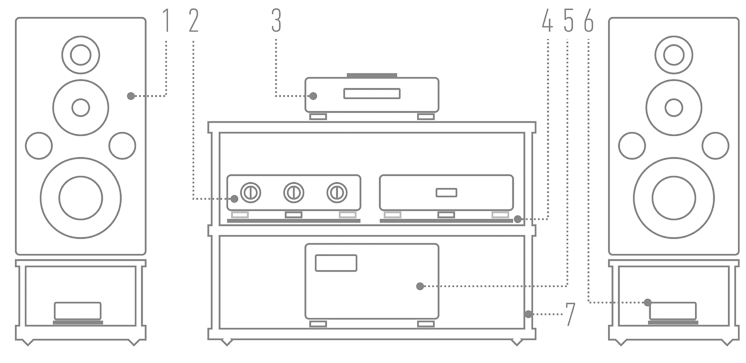|
LOUDSPEAKERS ⸜ floor-standing YG ACOUSTICS
Manufacturer: YG ACOUSTICS LLC |

|
Review text by WOJCIECH PACUŁA translation Marek Dyba images by “High Fidelity”, Harbeth |

|
No 252 May 1, 2025 |
IN THE WORLD OF LITERATURE, there is something that could be called a first sentence fetish. It is believed that the opening of a novel, short story, or even a poem somehow establishes its importance and how the entire work will be received. 
In this context, the most frequently cited reference is Gabriel García Márquez's One Hundred Years of Solitude, where it reads as follows: “Many years later, as he faced the firing squad, Colonel Aureliano Buendía was to remember that distant afternoon when his father took him to discover ice,” or Milan Kundera's The Unbearable Lightness of Being: If eternal return is the heaviest of burdens, then our lives can stand out against it in all their splendid lightness. to take the most obvious examples. You can find more in the Culture portal article aptly titled: “35 sentences for a good start to a book,” read → HERE ˻PL˺. Personally, I was most impressed by the beginnings of novels by John Irving, author of, for example, The World According to Garp, one of my favorite contemporary American writers. He begins A Prayer for Owen Meany as follows: “I am doomed to remember a boy with a wrecked voice—not because of his voice, or because he was the smallest person I ever knew, or even because he was the instrument of my mother's death, but because he is the reason I believe in God; I am a Christian because of Owen Meany.” But this author said something else: ”I begin all my novels with the last sentence. (...) The last sentence is like the culmination, the final chord. If I know where I want to go, how that final chord will sound, then I can write.” Perhaps it is not only what happens at the beginning that matters, but also what happens at the end. Or maybe only what happens in between? This thought crossed my mind when two strong guys barged into my place with a pair of YG Acoustics Vantage 3 speakers. These weigh 85 kilograms a piece (without the equally heavy boxes) and measure 1120 × 330 × 540 mm. All this mass is contained in a small space. So, while the beginning was Yoav Geva's work – hence the YG in the company name – and we don't know the end, somewhere between these extremes we are witnessing its incredible development. ▌ Beginning and end WHAT I MEAN IS that this company did not start out by laboriously climbing up the quality and price ladder, but almost right after moving from Israel to the US, it offered very expensive, top-of-the-line speakers featuring its proprietary solutions, primarily an innovative crossover design. This was the result of adapting Geva's work from his previous life and required ultra-precise components. The crossover design allowed him to achieve a flat frequency response with consistent phase (which is unique), and he called his solution DualCoherent. Initially, all drivers were purchased from Scan Speak and came from the Illuminator (tweeters) and Revelator (other) series. New, self-manufactured drivers appeared in the latest incarnations of the Kipod and Anat models. The first modified tweeters date back to the Carmel 2 model, which we wrote about in 2016, more → HERE. And it is the drivers, as I see it, that have changed the course of the company's history. They are technologically advanced and manufactured differently than the vast majority of drivers of this type. The starting point for the production of membranes at YG is a flat piece of aircraft aluminum (6061-T651), the cone is milled from, not extruded. Incidentally, they are made on German Gildemeister CTX Beta 1250 TC machines, and this technology has been named BilletCore. The membrane is reinforced from behind with ribs, creating an extremely light, homogeneous and rigid piston. The manufacturer once stated that it takes up to four hours to make one driver, with a precision of up to 20 microns. The initial idea to create their own drivers dates back to 2007, but it took the company four years to develop the right technology – the first transducer was created in 2011. The tweeters are purchased from Scan Speak. However, they feature an element that makes the naturally soft silk membrane incredibly rigid. It's a kind of reinforcement glued to the back. I remember when Kerry St. James, then head of sales and marketing, now holding the same position at Nagra (see the pattern?), showed me this design in Munich about ten years ago, I couldn't believe that no one had thought of this before. 
The reinforcement in question is shaped like a „spider”, with a shape adapted to the dome. It is very thin, but it is also milled from a single aluminum element. It is also used in the latest models, although its shape has changed and now resembles a honeycomb. As before, the tweeter is located in the center of the acoustic lens, which is designed to improve phase at the crossover point. That's it for the basics. In 2017, to the surprise of many, Yoav Geva sold the company to a group of investors from Colorado. Although he continued to work as a consultant for some time, he left YG for good in 2020. The investors then established a partnership with Cambridge Acoustic Sciences (CAS) in Cambridge, England, resulting in Dr. Matthew Webster becoming the CEO of this loudspeaker manufacturer. Since completing his PhD in astrophysics at Cambridge, he had been applying detailed computational modeling in a number of industries. However, his second passion was audio – he was an audiophile. As the company explains:
YG Acoustics' research and development is largely conducted in the UK by Cambridge Acoustic Sciences, but the company itself remains a Colorado-based enterprise. Since the change of ownership, over two million dollars has been invested in its Arvada factory, which now uses – to quote the company's own materials – “more floor space, more CNC machines, and more production staff.” Circling back to the beginning, we should ask ourselves: which of these “statements,” or steps, came first for YG? Was it establishing the company in Israel, moving it to the US, or switching to its own drivers? Or perhaps the change of ownership and design team? You can choose for yourselves. In my opinion, what is happening now is more important. Anticipating events and referring to what Irving said, I will mention that as I write these words, having already listened to the speakers, I know what the final verdict of this test will be. And that seems to me to be the most important thing. ▌ Vantage 3 VANTAGE 3 IS THE THIRD VERSION OF THE SPEAKERS introduced to the market in 2020, not counting the active version Vantage Live (more → HERE ˻PL˺). The dimensions, selected drivers and their placement remain unchanged. However, in subsequent versions, the crossover was redesigned, changing the crossover point between the two sections, moving it in version “3” from 65 to 90 Hz. Although the frequency response range remained unchanged at an impressive 26–40,000 Hz, other changes were made to the crossover, improving phase linearity and slightly reducing the minimum impedance from 3 to 2.8 Ω. YG Acoustics speakers belong to a group of audio products that have been developed through careful engineering, precise calculations, and measurements. To be honest, this approach reminds me of the work of BBC engineers, which we will return to in this test. We also read that the Vantage 3 model benefits from the latest developments and “hundreds of hours of listening”. Among its most important features, the company lists:
• Ultra-coherent circuit with crossovers at 90 Hz and 1.75 kHz, These speakers belong to the Reference series, which, as you might guess, is the company's top-of-the-line offering, but they are also one of the most affordable models in the series. The manufacturer writes about them:
We are talking about floor-standing design featuring a three-way design and a closed cabinet. They are clearly divided into two parts, a mid-high frequency module and a low frequency module. This is an optical division, as the enclosure is shared by both, but it also shows the division inside – the upper part is separated in the middle by an aluminum plate. All other baffles, as well as the internal reinforcements, both horizontal and vertical, are also made of aluminum. High frequencies are reproduced by a hybrid tweeter in which the soft dome has been stiffened. It features a proprietary drive system called ForgeCore, which, according to the manufacturer, uses “complex 3D machining” of internal components to achieve “a radical reduction in distortion compared to even the best off-the-shelf tweeters.” The midrange driver, with a diameter of 185 mm, features a BilletCore cone and neodymium magnets, while the low frequencies are reproduced by a 220 mm driver, also BilletCore, with a drive system that the manufacturer describes as having “ultra-high magnetic field strength.” The latter is cut off at 90 Hz, almost like a subwoofer. So we can say that we are dealing here with a two-way monitor and a bass module. The cabinets of YG Acoustics speakers in this series are CNC-machined from thick aircraft-grade aluminum plates and joined together using “vibration-free pressure mounting” techniques. They utilize the company's patented FocusedElimination anti-resonance technology, which the company says keeps “mechanical losses lower than any competitive speaker by combining minimized turbulence inside the enclosed cabinet with the low distortion associated with open-cabinet designs.” The shape of the cabinet is immediately apparent. It is a motif characteristic of this manufacturer, resembling an obelisk tapering towards the top. As is well known, it was developed in collaboration with Porsche Design. One of its most interesting aspects is that the cabinet panels appear to be flat, but when you look more closely, they turn out to be composed of delicate curves. 
The sides of the enclosure are precisely machined, then finished to a satin sheen and anodized in black or silver. The front is additionally finished in such a way that it is not uniformly flat. The speakers are mounted on three spikes. It should be added that they feature single terminals, the top model from WBT with rhodium-plated contacts. And that the Vantage 3 are perfectly made and look great. ▌ SOUND HOW WE LISTENED • The YG Acoustics Vantage 3 speakers were placed in a semi-near field, slightly closer than usual. I wanted them to be as far away from the rear wall as possible. This means that they were placed 240 cm away from the listening position and 220 cm apart (measured from the center of the front panel). They were 52.5 cm from the rear wall, measured from the center of their rear panel. During the test, the speakers were toed-in so that the driver axes crossed in front of my head. 
I determined the distance between the speakers and their leveling using a Bosch PLR 50 C. For more on positioning the speakers, see the article FINE-TUNNING, or how to set up speakers, HIGH FIDELITY № 177, January 1, 2019, → HIGHFIDELITY.pl, accessed May 10, 2022. For more on HF listening room acoustics, see the article Room acoustics and how it works according to Mariusz Zielmachowicz, HIGH FIDELITY № 189, January 1, 2020, → HIGHFIDELITY.pl, accessed 12.07.2022. The speakers were driven using SOULUTION 710 power amplifier, and the signal was transmitted via SILTECH TRIPLE CROWN speaker cables. The reference speakers were HARBETH M40.1. The music was played using AYON AUDIO CD-35 HF SACD player. |
» RECORDINGS USED FOR THE TEST ⸜ a selection
⸜ KENICHI TSUNODA BIG BAND, Big Band Supreme, Mixer’s Lab/Warner Music Japan WPCL-13559, SACD/CD (2024). I REMEMBERED THAT ONE OF THE CONCLUSIONS that stuck in my mind after testing the Hailey 1.2 speakers was that they could be compared to ultra-precise monitors with extended dynamics, scale and sound power; more → HERE. But still – monitors. This was influenced by the way the bass was handled. It was incredibly accurate and superbly controlled, both in terms of attack and decay. However, it lacked the fullness that I get right out of the box with the Harbeth M40.1, which were already my reference speakers at the time. 
I was a little afraid about it when the Vantage 3s were placed in the same spot as the model I mentioned earlier. Unnecessarily so. It's a completely different approach to how hi-tech speakers can be designed. It's as if a new design team had changed their perspective and view of what can be achieved with this type of construction. On the other hand, it is not a break with the model developed by Yoav Geva. It is more of a modification, but in my opinion, a creative one that goes quite deep. The sound of the new speakers is richly saturated. This is a complete departure from the cold precision known from previous generations of speakers from this company (I would add: from the “cold,” not the “precision” part). To avoid any misunderstanding: this is not BBC sound and never will be. There are companies offering this approach to music, and copying them would be silly. YG offers something different, where all elements have their place and are perfectly balanced. But not in a cool, detached way, but rather in an engaged, kind of “gutty” one. I can't explain it any other way, but as soon as I heard ˻ 1 ˺ „Sing, sing, sing, sing…” sung on the album by KENICHI TSUNODA BIG BAND Big Band Supreme by Charito, a Filipino singer living in Japan, when the soft drums hit and the wind instruments came in, I saw a colorful and incredibly natural panorama in front of me. The depth of her voice, influenced by Sarah Vaughan, velvety yet slightly husky, was flawless and simply – oh my God, I'm saying it (!) – warm. Yes – natural and inner warmth are the first words that come to mind when listening to these speakers. This is an incredible change and a unique achievement for speakers from an engineering company not affiliated with the BBC. Not that what I heard with the Haileys was bad; they were flawless speakers that charmed me. It's just that they weren't really for me. The Vantage 3, on the other hand, are in a different league. Even though they still deliver incredibly precise sound. In a system with them, a very deep window opens up before us, without going sideways; they are not that type, but they offer outstanding positioning of sound sources far away on the stage. Big band music is extremely difficult to reproduce because it involves many instruments, usually playing loudly and dynamically. This can easily turn into chaos, both during recording and playback. But not with YG, Soulution, Ayon, and Siltech, to name (almost) the entire system. With these speakers, changing the cables from Siltech Triple Crown to Master Crown will be a game changer, because they will reveal every nuance of the difference and translate it into even better sound, as I see it. The basis for their excellent sound reproduction is the wonderful balance between high and low frequencies, manifested in a rich, dense, yet highly accurate midrange. What struck me first was the way the tested speakers handled the cymbals and percussion instruments. This is one of the best tweeters I know – I have no doubt about that – but it is also one that combines the advantages of other designs. Oscar Heil's AMT drivers give us sweetness, ribbon drivers give us speed, and classic silk domes give us richness and precision. However, if I had to point out one thing, it would be its precise sweetness. That is why even the difficult-to-reproduce fragment played by PATRICIA BARBER in ˻ 7 ˺ Black Magic Woman, a cover of Carlos Santana's song originally ending the album Companion, was played by these speakers exactly as I was used to with Harbeth speakers. In turn, the guitar solo in the second part of the song sounded more aggressive, stronger, at times almost “painful” – that is, more like it should be. But that's not what struck me the most. What impressed me the most was Barber's voice. It was warm, tangible, and rich. These are things that were not present in older versions of these speakers and had to be “injected” with the right components around them. I could have said this about the big band album, but now it came across twice as strong. Because it was accompanied by perfect precision. Let's be honest – these speakers deliver better treble than my Harbeths and more precisely formed bass. Both extremes are strong, accurate, but also rich. They are simply beautiful in their colorful fullness. The sound attack of these speakers is extremely accurate, reminiscent of the best studio monitors. At the same time, they are not dry or bright. They are musical. This is the change I wrote about in my February editorial, concerning contemporary audio in general, which is also evident in this transition from precision of detail to precision of soundstage; more in the column Dark, darker, wonderful. That is, about sound in 2025 → HERE. The speakers go very deep in the bass, almost as low as it is possible in my room. This is what I heard with the two previous albums and with subsequent ones, which I always use to check this aspect of the sound. However, since their sound does not feature the correction I have in the M40.1 speakers, which consists of a slight emphasis in the range around 60 Hz, it seems that there is less bass with them. I haven't measured it, but from what I hear, the total energy in both cases is similar. With the YG, the bass is simply reproduced in more linear way. 
I'm not saying that they are generally and unconditionally better, but rather that they are less affected. Because it is still the Harbeths that sound more enthusiastic, with a more pronounced upper bass and lower midrange. However, the Vantage 3 are the first speakers from this company that are, in my opinion, something of a “modern BBC”. I love Harbeths, I'm a fan of Spendor, Falcon and Graham speakers. All of these are speakers that were created as studio monitors in the rigorous BBC design process, which were intended to reproduce what was happening through the microphones in the concert hall as precisely and perfectly as possible. At the same time, however, I know, or at least some part of my subconscious knows, that although they are beloved and unique, they are nevertheless a reflection of the knowledge, skills, and technological capabilities of fifty years ago and more. There is nothing wrong with that; it is wonderful, it is the foundation, the ABCs of design. And yet, you can't lock yourself in an ivory tower and pretend that everything that came after is worse, that's nonsense. I am deeply convinced that if there were a British Broadcasting Corporation research department dedicated to acoustics and speaker design today, it would want the MAYO NAKANO PIANO TRIO's Miwaku to sound like it does on the Vantage 3. This is because it is a very, very energetic sound with its energetic saturation. The sound attack must be extremely precise because the events on the stage in front of me are shown accurately, along with reverberations and relationships with other events. I cannot say that this is obvious, because in this generation of YG Acoustics speakers, it is hidden under a saturated sustain. That is to say, it does not draw attention to itself. You could even say that it exists like Schrödinger's cat – it is only real when we look at it. When we look away for a moment, it seems to disappear. So what is it about this sound that my Harbeths do differently, potentially even better? To be honest, there isn't much, and in a few areas they are clearly inferior to American designs. It's not much, but there is something there. However, it is these details that ultimately differentiate various designs. First of all, the M40.1s produce a more tangible sound. It's almost as if it's within reach. The YG also sounds similar, but in their case more energy is located in the depth of the soundstage. The Harbeths emit it closer to us. The bass of British monitors also seems more tangible, energizing the room more, as a whole, from A to Z. The Vantage 3 sounds a bit more restrained. It's as if they stop halfway through, and the Harbeths finish it. This does not mean that they do it better, but differently. However, as I said, even such changes alter the perception of sound as a whole. This is why the tested speakers project sound deep into the scene, in front of us, while the M40.1 fill the entire room with sound, including the space around us. This is probably also why both designs present sound in a completely different way, which is not entirely audiophile. YG are very principled. They don't let mistakes slide, they don't try to force out the good – they present recordings as they are. So when THE POLICE's Synchronicity starts playing, even in such a successful remaster as the 2024 version, it sounds flat, both tonally and dynamically. That's just how it was recorded. Harbeths, on the other hand, will try to extract more color, juice, and spaciousness from it. With American speakers, the title track sounded almost monophonic, while Harbeths broadened the base. ▌ Summary SO WHERE DOES THE TRUTH LIE? How should an audio system sound like? Should it be a “lens” for recordings, or should it try to reach their inner truth, their intention? Should it be a transmitter, or should it influence the audio signal in such a way that any music can be listened to? With YG Acoustics' Vantage 3, it's not entirely true that you can't listen to something that isn't perfect in terms of sound quality. The new generation of its speakers offers such great saturation and depth that once your ears have adjusted, you can enjoy all your recordings, even those that aren't perfect in this respect. However, the transition from good to problematic recordings is abrupt and happens without warning. 
However, perhaps it is just habit and my personal needs speaking. Because when we sat down with my daughter the day before the actual listening session to listen to the song ˻ 1 ˺ Rumours About Angels, from the album by DIARY OF DREAMS titled One Of 18 Angels, she immediately liked what she heard. The sound quality isn't very good, but the music is perfect, even iconic for me. And it was this “iconic status” that was most important to my daughter, and YG conveyed it to her. Because when I played her the acoustic version of the song, recorded much better and released in 2012 on the album The Anatomy of Silence, she found it boring. The original, even though it sounded much worse, had the power, depth, and energy that this song requires, which the American speakers conveyed precisely and with reverence. Because that's what these speakers are like. They present sound without any embellishment. They show it as it is. But in its entirety. With perfect tones, power, and excellent bass. In a warm, sweet, and musical way. But still incredibly clear. This is how top contemporary speakers sound. ● ▌ Technical specification (according to the manufacturer)
Frequency range: 26 Hz - 40 kHz 
THIS TEST HAS BEEN DESIGNED ACCORDING TO THE GUIDELINES adopted by the Association of International Audiophile Publications, an international audio press association concerned with ethical and professional standards in our industry, of which HIGH FIDELITY is a founding member. More about the association and its constituent titles → HERE. |

|
Reference system 2025 |
|
 1) Loudspeakers: HARBETH M40.1 |REVIEW| 2) Line preamplifier: AYON AUDIO Spheris III Linestage |REVIEW| 3) Super Audio CD Player: AYON AUDIO CD-35 HF Edition No. 01/50 |REVIEW| 4) Stands (loudspeakers): ACOUSTIC REVIVE (custom) |ABOUT| 5) Power amplifier: SOULUTION 710 6) Loudspeaker filter: SPEC REAL-SOUND PROCESSOR RSP-AZ9EX (prototype) |REVIEW| 7) Hi-Fi rack: Hi-Fi rack: finite elemente MASTER REFERENCE PAGODE EDITION Mk II, more → HERE |
|

|
Cables Analog interconnect SACD Player - Line preamplifier: SILTECH Triple Crown (1 m) |ABOUT|» ANALOG INTERCONNECT Line preamplifier → Power amplifier: Siltech ROYAL SINLGE CROWN RCA; review → HERE Speaker cable: SILTECH Triple Crown (2.5 m) |ABOUT| |

|
AC Power Power cable | Mains Power Distribution Block - SACD Player: SILTECH Triple CrownPower (2 m) |ARTICLE| » POWER CABLE Mains Power Distribution Block → Line preamplifier: Acoustic Revive ABSOLUTE-POWER CORD, review → HERE » POWER CABLE Mains Power Distribution Block → Power amplifier: Acoustic Revive ABSOLUTE-POWER CORD, review → HERE Power cable | Power Receptacle - Mains Power Distribution Block: ACROLINK Mexcel 7N-PC9500 (2 m) |ARTICLE| Power Receptacle: Acoustic Revive RTP-4eu ULTIMATE |REVIEW| » ANTI-VIBRATION PLATFORM under Acoustic Revive RTP-4eu ULTIMATE: Graphite Audio CLASSIC 100 ULTRA, review → HERE Power Supply Conditioner: Acoustic Revive RPC-1 |REVIEW| Power Supply Conditioner: Acoustic Revive RAS-14 Triple-C |REVIEW| Passive filter EMI/RFI: VERICTUM Block |REVIEW| |

|
Anti-vibration Speaker stands: ACOUSTIC REVIVE (custom)Hi-Fi rack: finite elemente MASTER REFERENCE PAGODE EDITION Mk II, more → HERE Anti-vibration platforms: ACOUSTIC REVIVE RAF-48H |ARTICLE| » ANTI-VIBRATIONAL FEET: |

|
Analogue Phono preamplifier: Phono cartridges:
Clamp: PATHE WINGS Titanium PW-Ti 770 | Limited Edition Record mats:
|

|
Headphones » HEADPHONE AMPLIFIER: Leben CS-600X, review → HEREHeadphones: Headphone Cables: Forza AudioWorks NOIR HYBRID HPC |
main page | archive | contact | kts
© 2009 HighFidelity, design by PikselStudio,
projektowanie stron www: Indecity




















